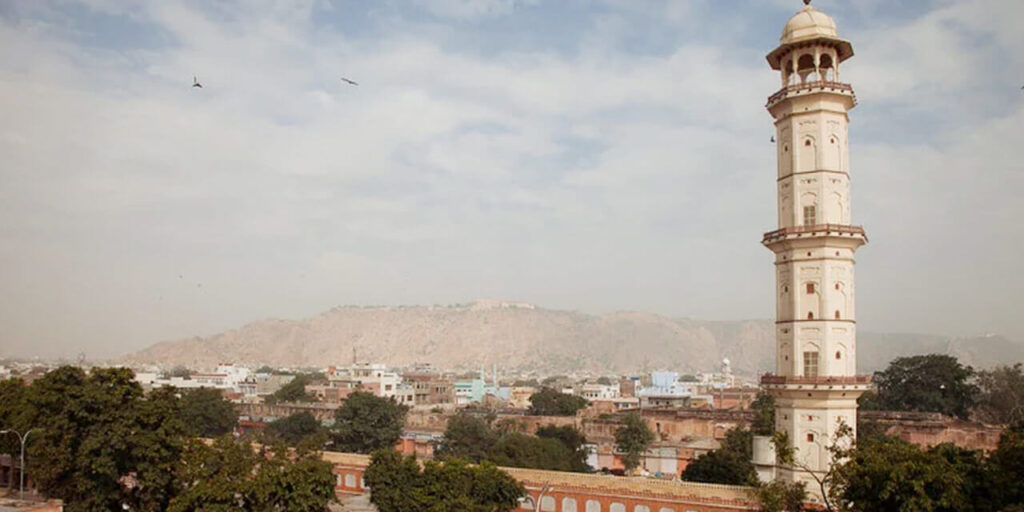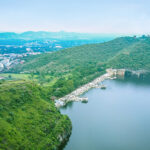Swargasuli Tower Jaipur: A Majestic Heritage of Jaipur’s Royal Past
In the heart of Jaipur, where the city’s historical beauty converges with its dynamic modern-day life, stands a building wonder that murmurs stories of a lost era—Swargasuli Tower. This iconic site, also known as the “Paradise Piercer” or “Sargasuli,” is not simply a monument but a testament to the grandeur and vision of the Rajput leaders. Standing tall amidst the pressures of contemporary Jaipur, Swargasuli Tower provides a unique look into the city’s rich heritage and its imperial past.
Historical Significance
Constructed in 1749 by Maharaja Sawai Jai Singh II, the founder of Jaipur, the Swargasuli Tower was initially built as a triumph tower. Its main purpose was to celebrate the king’s victory over the Mughals, mirroring the martial spirit and ambition of the Rajput rulers. The tower’s name, “Swargasuli,” translates to “Heaven Piercer,” symbolizing the king’s desire for his reign to reach celestial heights. This monument is one of the earliest structures in Jaipur, showcasing the architectural style and magnificence of the time.
Architectural Marvel
The Swargasuli Tower stands as an impressive example of Rajput architecture, integrating both functional and aesthetic elements. It is a cylindrical tower, rising about 60 feet (18 meters) high, with a series of four distinct levels. Each level is adorned with intricate carvings and decorations, showcasing the exceptional craftsmanship of the artisans of that era.
The base of the tower is a square platform with a robust, solid design, providing stability and grandeur. As one ascends, the structure becomes increasingly slender, culminating in a delicate and elaborate spire. This tapering design not only enhances the tower’s visual appeal but also reinforces its stability and endurance against the elements.
The tower is built from sandstone, a material that is both durable and aesthetically pleasing. The sandstone has been meticulously carved to include motifs and patterns typical of Rajput art, including floral designs and geometric patterns. The tower’s exterior is adorned with beautiful lattice work, allowing light and air to filter through, adding a touch of elegance and functionality to its design.
The View from the Top
One of the most compelling aspects of Swargasuli Tower is the panoramic view it offers. Climbing to the top of the tower provides a breathtaking view of Jaipur, allowing visitors to appreciate the layout of the city and its surrounding landscape. From this vantage point, one can see the bustling streets of the Pink City, the sprawling forts, and the serene Aravalli hills that frame the horizon.
The view from Swargasuli Tower is a visual feast, capturing the essence of Jaipur’s historical and cultural landscape. On clear days, the vistas extend far beyond the city, offering glimpses of the neighboring towns and the expansive desert landscape that characterizes much of Rajasthan. This vantage point not only provides a historical perspective but also offers a moment of serene reflection amidst the city’s vibrant energy.
Swargasuli Tower in Modern Times
In contemporary Jaipur, Swargasuli Tower stands as a symbol of the city’s rich heritage and historical significance. Although it is not as widely visited as some of Jaipur’s other landmarks, such as the Hawa Mahal or Amber Fort, it holds a special place in the hearts of those who appreciate the city’s deep historical roots.
The tower has been preserved with care, maintaining its original charm while adapting to the needs of modern visitors. Efforts have been made to ensure that the monument remains accessible and informative, with informative plaques and guides available to enhance the visitor experience. The surrounding area has been landscaped to provide a pleasant environment for tourists, with pathways and seating areas that allow for leisurely exploration and contemplation.
Cultural and Tourist Significance
Swargasuli Tower is more than just a historical monument; it is a cultural touchstone for Jaipur. It serves as a reminder of the city’s regal past and the visionary leadership of Maharaja Sawai Jai Singh II. For tourists, it offers a less crowded yet profoundly enriching experience compared to some of Jaipur’s more famous attractions.
Visitors to Jaipur often seek out Swargasuli Tower for its historical ambiance and the opportunity to explore a piece of the city’s past that is often overshadowed by its more prominent landmarks. The tower’s unique architecture and historical context make it a compelling stop for those interested in the depth and breadth of Jaipur’s heritage.
A Legacy of Vision and Triumph
Swargasuli Tower remains a testament to the vision and triumph of Maharaja Sawai Jai Singh II. It embodies the spirit of an era where architectural prowess and royal ambition converged to create structures of enduring significance. The tower’s imposing presence and intricate design continue to captivate visitors, offering a glimpse into the grandeur of Jaipur’s past.
As Jaipur continues to evolve and modernize, Swargasuli Tower stands as a timeless beacon, connecting the present with the rich legacy of the city’s royal history. It serves as a reminder of Jaipur’s enduring charm and the remarkable achievements of its historical rulers. For anyone visiting Jaipur, a trip to Swargasuli Tower is a journey back in time, a chance to experience the city’s regal past, and a reminder of the indomitable spirit that shaped this magnificent city.
In exploring Swargasuli Tower, one does not merely visit a historical site; one immerses oneself in the rich tapestry of Jaipur’s history, culture, and architectural splendor.
For more information on exploring Jaipur and other Rajasthan destinations, check out our Rajasthan Tour Packages.
1.Historic Value
Q1.: When was the Swargasuli Tower constructed, and by whom?
A: The Swargasuli Tower was constructed in 1749 by Maharaja Sawai Jai Singh II, the creator of Jaipur. It was originally developed as a triumph tower to commemorate the king’s triumph over the Mughals, mirroring the martial spirit and passion of the Rajput leaders.
Q2.: What does the name “Swargasuli” mean?
A: The name “Swargasuli” equates to “Heaven Piercer,” representing Maharaja Sawai Jai Singh II’s need for his power to reach holy heights. The tower was developed to memorialize the king’s triumph and mirror his regal aspirations.
2.Building Wonder
Q1.: What are the crucial building features of the Swargasuli Tower?
A: The Swargasuli Tower is a cylindrical framework standing around 60 feet (18 meters) high, including four distinctive degrees. Each level is adorned with elaborate makings and decorations showcasing the extraordinary craftsmanship of the age. The tower tapers as it rises, finishing in a delicate spire. It is developed from sandstone, which has been meticulously sculpted with Rajput art concepts, consisting of flower layouts and geometric patterns. The outside is decorated with latticework work that allows light and air to infiltrate.
Q2.: Exactly how does the tower’s layout contribute to its sturdiness and visual appeal?
A: The tapering design of the Swargasuli Tower enhances its aesthetic charm while strengthening its security and resilience. The robust base supplies a solid foundation, and the slender, delicate apex on top contributes to both the tower’s elegance and its ability to endure the elements.
3.The View from the Top
Q1.: What can site visitors see from the top of Swargasuli Tower?
A: From the top of Swargasuli Tower, visitors are dealt with to a panoramic view of Jaipur. The view consists of the bustling roads of the Pink City, the stretching fts, and the peaceful Aravalli hillsides. On clear days, the sight expands beyond the city, supplying glances of surrounding towns and the large desert landscape that identifies much of Rajasthan.
Q2.: Just how does the view from Swargasuli Tower add to the site visitor experience?
A: The sight from Swargasuli Tower provides a historic viewpoint on the format of Jaipur and its environments. It offers a minute of calm representation among the city’s vibrant power, allowing site visitors to value the city’s historic and cultural landscape in a special and extensive means.
4.Swargasuli Tower in Modern Times
Q1.: How is Swargasuli Tower preserved and maintained in modern times?
A: In modern Jaipur, Swargasuli Tower has been carefully protected to preserve its original appeal while adapting to the needs of modern visitors. Helpful plaques and guides are readily available to boost the visitor experience, and the bordering area has been landscaped to give a pleasant setting with pathways and seating areas for leisurely expedition.
Q2.: What function does Swargasuli Tower play in Jaipur’s social and traveler landscape?
A: Swargasuli Tower works as a cultural example for Jaipur, reminding visitors of the city’s regal past and the visionary management of Maharaja Sawai Jai Singh II. It offers a less congested yet improving experience compared to more famous landmarks, making it a compelling stop for those interested in the depth of Jaipur’s heritage.
5.A Legacy of Vision and Accomplishment
Q1.: What does Swargasuli Tower symbolize in terms of Jaipur’s background and heritage?
A: Swargasuli Tower signifies the vision and victory of Maharaja Sawai Jai Singh II. It represents a period where building prowess and royal passion merged to develop structures of lasting value. The tower’s enforcing presence and detailed style provide a glance right into the grandeur of Jaipur’s past and its long-lasting heritage.
Q2.: Why is a visit to Swargasuli Tower substantial for vacationers?
A: Seeing Swargasuli Tower uses vacationers a trip back in time, supplying a chance to experience Jaipur’s regal past and appreciate the indomitable spirit that shaped the city. It enables site visitors to immerse themselves in the abundant tapestry of Jaipur’s history, culture, and architectural beauty.
For additional information on discovering Jaipur and various other Rajasthan destinations, look into our Rajasthan Tour Bundles.



